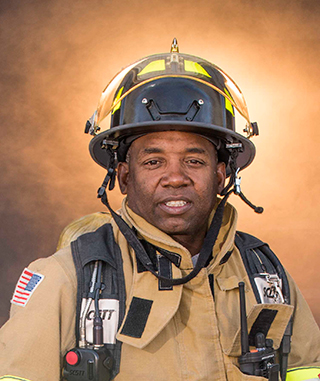
A five-man Emergency Response Team from Sandia (left to right in team photo, above), including, John Ledet (pictured here), Dale Larez, Victor Marquez, Richard Lovato, and Troy Hamby nabbed top technical honors at the recent 19th HAZMAT Challenge at Los Alamos National Laboratory. (Photo by Randy Montoya)
A five-man Emergency Response Team (ERT) from Sandia nabbed top technical honors at the 19th HAZMAT Challenge at Los Alamos National Laboratory (LANL).
During the weeklong competition the team faced numerous simulated hazardous-material emergencies, including a downed C-130 military aircraft transporting Ebola-infected patients, industrial pipe leaks, and the rescue of a patient trapped in a clandestine laboratory filled with an unknown chemical.
The scenarios were similar to real-life emergencies that have occurred worldwide and were graded on technical approach as well as time needed to complete the tasks.Sandia team members included HAZMAT supervisor Victor Marquez, Dale Larez, John Ledet, Troy Hamby, and Richard Lovato (all 4236-1).
A total of 12 HAZMAT response teams from New Mexico, Missouri, and Nebraska completed a series of graded, timed exercises where seconds, rather than minutes, meant the difference between first, second, and third place. Trophies were awarded for technical, best overall, and sportsmanship.
“Sandia’s ERT successfully responded to the challenges presented and was awarded first place in the technical category. The competition demonstrated the team’s capabilities to respond to emergencies,” says Eugene McPeek, manager of Emergency Management Dept. 4236. “These challenges provide Sandia the opportunity to demonstrate proficiencies and, as a result, give members of the workforce confidence that these skills would transfer to real-world incidents at Sandia.”
The event gave the teams opportunities to test their skills, share best practices with their colleagues, and learn new techniques through realistic scenarios in a safe, non-hazardous environment.
‘This is the category you want to win’
“We’ve come so close for so many years, and we’ve lost by small points — it’s come down to one point or one-half of a point before — and it’s frustrating,” says former Sandian Steve Saddoris, the team’s HAZMAT trainer and logistics coordinator, who recently left the Labs. “This year the team went in wanting to win the technical portion and, for the first time, they got it. If you’re going to win anything, this is the category you want to win.”
This team won by 14 points, a huge margin, say Eugene and Steve. Steve credits the team’s win to the weekly HAZMAT, technical rescue, and classroom-based training Sandia ERT members take part in throughout the year, as well as their years of experience.
Typically, the team will start training for the challenge three months before it begins. Because real-world missions took priority, there were fewer training opportunities available compared to previous years. The team did, however, make a few trips to Los Alamos to practice on challenge props made available by LANL.
Victor and Dale agreed the win would not have been possible without help from others outside the team. “Aside from the mentally and physically taxing events we do at the challenge, it also serves as a unique training opportunity,” says Dale. “We are able to talk with other responders in the field and compare tactics and equipment, which is why it means so much that management from the top down has been supportive of this event.”
In addition, the team took Emergency Management Trainer Ricardo Paz (4236-3), a certified paramedic and medical instructor, to this year’s challenge. Ricardo monitored team members’ vital signs before and after each event, ensured safety gear was clean and ready to use, and resupplied water. Volunteers Victor Cepero (1741) and Marty Moriarty (1746, with MESA Microfabrication), also supported the ERT team, serving as stand-by members in the event of an accident, and filling water bottles and air tanks.
“This win is a testament to the training program we have here at Sandia. Between real-world events and training scenarios, we are prepared,” says Victor. “We want people to know that we are here, at Sandia, and if they ever need to call 911, we will be on the other end, ready to respond.”